We’ve all been there – you wake up looking like you haven’t washed your hair in weeks, even though you shampooed just yesterday. Greasy hair is one of those frustrating beauty battles that can make us feel self-conscious and desperate for answers that actually work.
The truth is, oily hair affects millions of people worldwide and it’s not always about poor hygiene or using the wrong products. Your scalp’s sebaceous glands produce natural oils called sebum, and sometimes they go into overdrive due to genetics, hormones, or environmental factors we can’t always control.
But here’s the good news – you don’t have to live with greasy hair forever. We’ve researched the most effective strategies, from tweaking your washing routine to choosing the right products, that’ll help you achieve fresh, clean-looking hair that lasts. Ready to transform your locks and boost your confidence?
Understanding What Causes Greasy Hair
Several biological and environmental factors contribute to oily hair production. We’ll explore the primary causes that lead to excessive sebum production on your scalp.
Overactive Sebaceous Glands
Sebaceous glands produce natural oils called sebum that normally protect and moisturize your hair and scalp. These microscopic glands are attached to each hair follicle and typically release just enough oil to keep your hair healthy. When sebaceous glands become overactive, they produce excessive amounts of sebum that accumulate on your scalp and hair strands.
Stress triggers increased sebum production through cortisol release. Your body responds to physical and emotional stress by producing more hormones that stimulate oil glands. Environmental factors like humidity, pollution, and heat also cause sebaceous glands to work overtime as they attempt to protect your scalp from external irritants.
Overwashing your hair paradoxically increases oil production. Many people strip their scalp of natural oils through frequent washing with harsh shampoos. Your sebaceous glands compensate by producing even more sebum to restore the protective barrier they perceive as missing.
Hormonal Fluctuations and Imbalances
Androgens like testosterone directly stimulate sebaceous gland activity. These hormones increase in both men and women during puberty, pregnancy, menstruation, and menopause. Higher androgen levels signal oil glands to produce more sebum, which explains why teenagers often struggle with greasy hair alongside acne breakouts.
Insulin resistance affects hormone balance and increases oil production. Diets high in refined carbohydrates and sugar cause insulin spikes that trigger androgen production. This hormonal cascade leads to overactive sebaceous glands and persistently oily hair that’s difficult to manage with standard washing routines.
Thyroid disorders disrupt normal sebum regulation. Both hyperthyroidism and hypothyroidism can cause changes in oil production patterns. Women experiencing PCOS (polycystic ovary syndrome) often deal with elevated androgen levels that result in excessively greasy hair and scalp conditions.
Genetic Predisposition to Oily Scalp
DNA determines your sebaceous gland size and oil production capacity. Some people inherit larger, more active oil glands that naturally produce higher amounts of sebum. Family history often reveals patterns of oily hair across generations, indicating strong genetic components in scalp oil production.
Ethnic background influences natural sebum levels and hair texture. People of European descent typically have more active sebaceous glands compared to those of African or Asian ancestry. Hair structure also affects how oils distribute along the hair shaft, with straight hair showing grease more readily than curly or textured hair types.
Age-related genetic expression changes oil production over time. Your sebaceous glands are most active during adolescence and gradually decrease production as you age. But, genetic factors determine whether you’ll maintain higher oil production into adulthood or experience important changes during hormonal transitions like menopause.
Identifying Common Greasy Hair Triggers
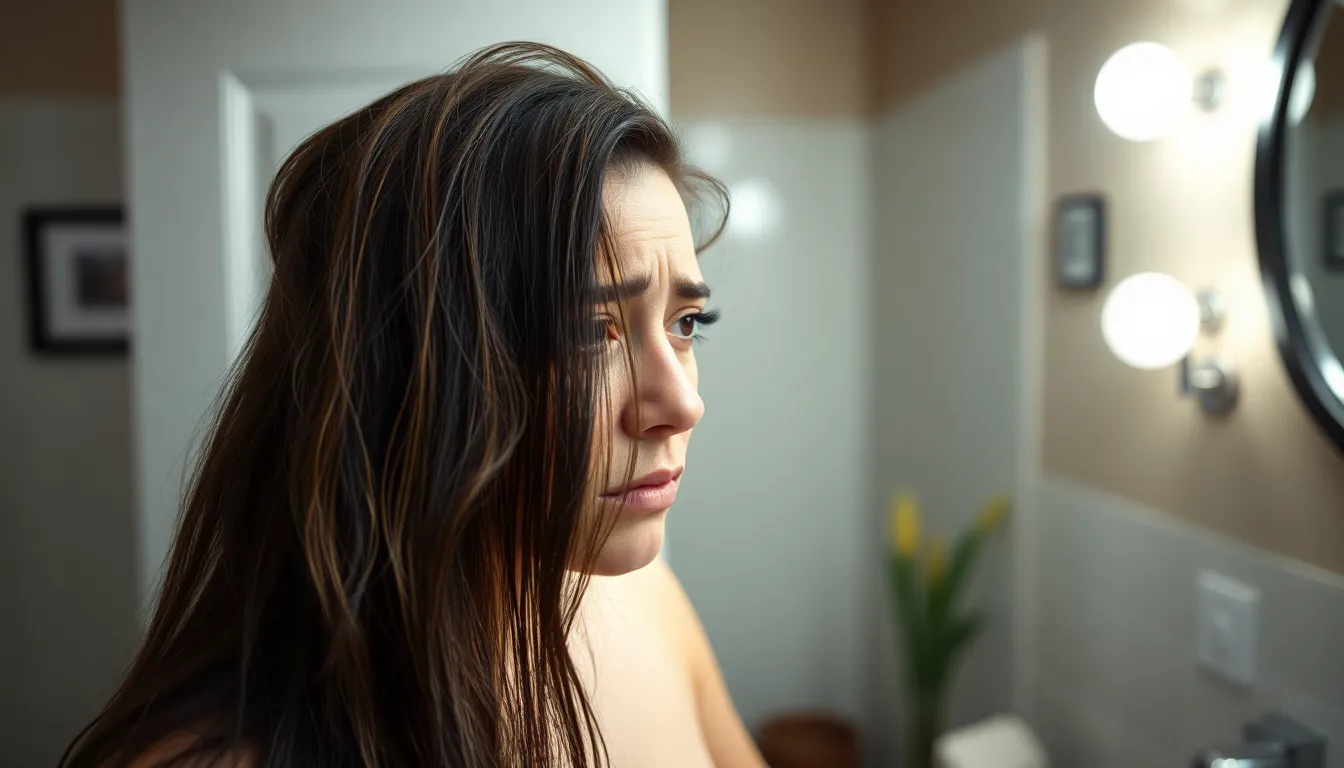
Several everyday habits and choices can trigger excess oil production in our hair without us realizing it. Understanding these common culprits helps us avoid behaviors that worsen greasy hair conditions.
Over-Washing Your Hair
Washing our hair too frequently strips away natural oils and triggers our scalp to produce even more sebum. Daily shampooing removes the protective oil barrier our scalp creates, causing sebaceous glands to go into overdrive. This creates a frustrating cycle where we wash more to combat grease, only to stimulate additional oil production.
Aggressive scrubbing during washing irritates our scalp and amplifies oil secretion. Harsh rubbing motions damage the delicate skin on our head, prompting inflammatory responses that increase sebum output. Hot water compounds this problem by opening hair cuticles and allowing more natural oils to escape.
Using clarifying shampoos daily depletes our scalp’s moisture balance completely. These powerful formulas contain sulfates and detergents designed for weekly use, not daily application. Frequent use leaves our scalp feeling tight and dry, triggering compensatory oil production within hours.
Using Heavy Hair Products
Oil-based serums and leave-in treatments create buildup that makes our hair appear greasier than it actually is. Products containing mineral oil, petroleum, or heavy silicones coat our hair strands and don’t wash out easily with regular shampooing. This residue attracts dirt and pollution, making our hair look dirty faster.
Applying conditioner to our roots adds unnecessary weight and oil to our scalp area. Conditioners work best on mid-lengths and ends where hair needs moisture, not near our sebaceous glands. Root application blocks hair follicles and creates a greasy appearance within hours of styling.
Using styling creams and pomades daily accumulates product residue on our scalp. These heavy formulations contain waxes and oils that build up over time, requiring deep cleansing to remove completely. Regular shampoo often can’t penetrate through these layers, leaving our hair perpetually coated.
Touching and Brushing Hair Excessively
Running our fingers through our hair transfers oils from our hands to our strands throughout the day. Our palms naturally produce sebum and collect oils from everything we touch, spreading this grease directly to our hair. Each touch session distributes these oils from roots to tips.
Over-brushing stimulates our scalp’s oil production and spreads existing sebum down our hair shaft. Brush bristles massage our scalp during each stroke, activating sebaceous glands to release more oil. This mechanical stimulation creates the same effect as a scalp massage, encouraging increased oil flow.
Using dirty brushes redistributes old oils and product buildup back onto clean hair. Brushes collect sebum, dead skin cells, and styling product residue with each use. Without regular cleaning, these tools become vehicles for reapplying yesterday’s grease to today’s fresh hair.
Choosing the Right Shampoo for Greasy Hair
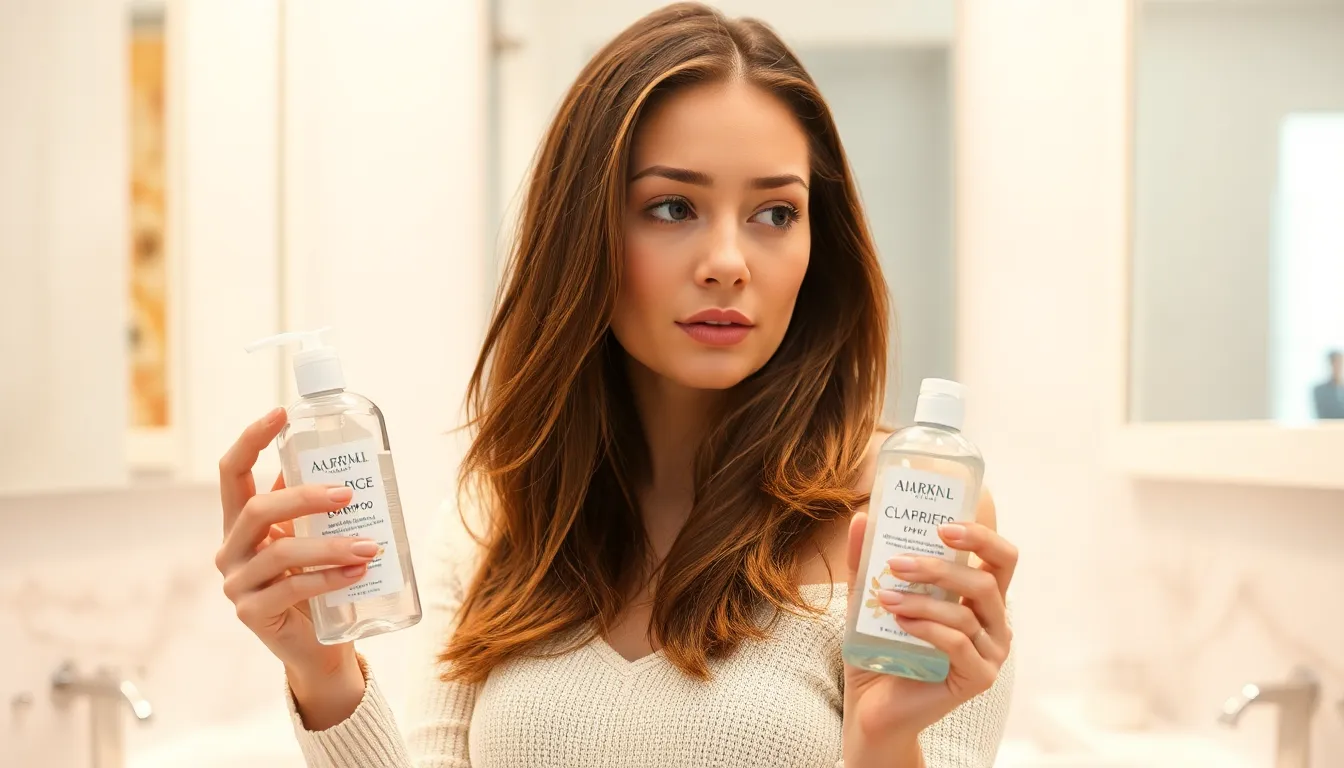
Selecting the perfect shampoo formula becomes crucial when managing excessive oil production and sebum buildup. We’ll explore three essential categories that address different greasy hair needs and scalp sensitivities.
Clarifying Shampoos for Deep Cleansing
Clarifying shampoos contain stronger surfactants like sodium lauryl sulfate that effectively strip away stubborn oil deposits and product residue. We recommend using these powerful formulas once or twice weekly to prevent over-drying your scalp. Look for ingredients such as tea tree oil, salicylic acid, or charcoal that provide additional deep-cleaning benefits.
Best results occur when you massage the clarifying formula into wet hair for 60 seconds before rinsing thoroughly. Popular options include Neutrogena Anti-Residue Shampoo and Paul Mitchell Clarifying Shampoo Two, which both target heavy sebum accumulation. Rotate between clarifying treatments and gentler daily shampoos to maintain balanced oil production without triggering rebound greasiness.
Sulfate-Free Options for Sensitive Scalps
Sulfate-free formulas use milder cleansing agents like coco glucoside or sodium cocoyl isethionate that remove excess oil without causing irritation. We find these gentler alternatives particularly effective for people with sensitive skin or those experiencing scalp inflammation from overwashing. Natural ingredients such as peppermint oil, rosemary extract, or zinc pyrithione help regulate sebum production while soothing irritated follicles.
These shampoos require slightly more product and longer massage time to achieve the same cleansing power as traditional sulfate formulas. Brands like SheaMoisture Green Tea and Lime and Living Proof Perfect Hair Day offer excellent sulfate-free answers for oily hair types. Daily use becomes possible with these formulations since they won’t strip your scalp’s protective barrier or trigger excessive oil compensation.
Dry Shampoos for Quick Fixes
Dry shampoos absorb excess sebum using ingredients like rice starch, corn starch, or clay powders that soak up oil between wash days. We suggest applying these products to roots and oily sections rather than coating your entire head for maximum effectiveness. Spray formulas work best on fine hair while powder versions suit thicker textures that need more absorption power.
Proper application involves sectioning hair and spraying 6 inches away from roots, then massaging the product through with fingertips after 2-3 minutes. Batiste Original and Klorane Oat Milk Dry Shampoo provide reliable oil control for up to 48 hours between washes. Remember that dry shampoos extend time between regular washes but shouldn’t replace proper cleansing routines completely.
Developing an Effective Hair Washing Routine
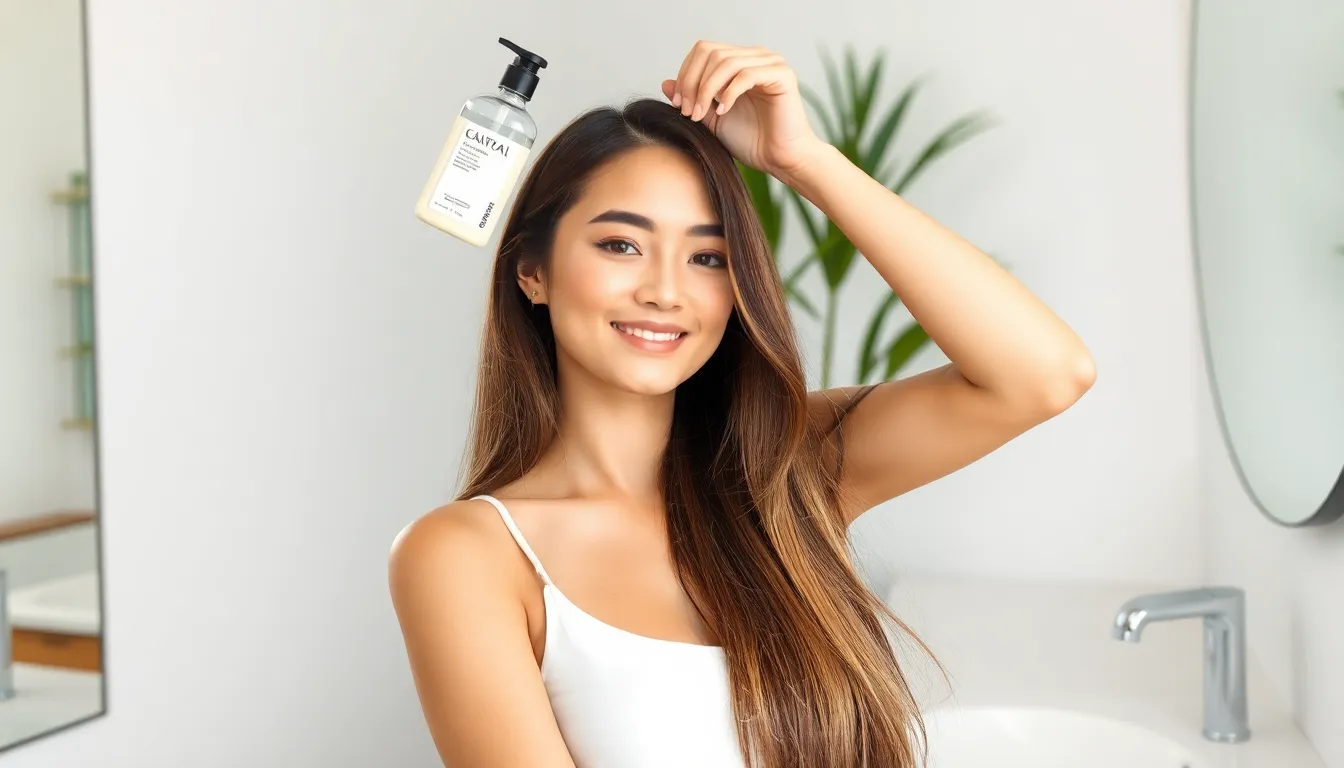
Building a consistent hair washing routine forms the foundation for managing greasy hair effectively. We’ll guide you through the essential components that make the difference between oily buildup and balanced, healthy-looking hair.
Optimal Washing Frequency
Daily washing isn’t necessary for most people with greasy hair. We recommend starting with every other day and adjusting based on your hair’s response. Washing too frequently strips natural oils, causing your scalp to overcompensate by producing even more sebum.
Fine hair typically requires more frequent washing than thick hair. People with fine strands often need to cleanse every 1-2 days, while those with coarser textures can extend to 2-3 days between washes. Your lifestyle factors also play a role – we suggest increasing frequency if you exercise daily or live in humid climates.
Monitor your scalp’s oil production patterns over 2-3 weeks. Some people notice their hair feels greasy by day two, while others can go three days comfortably. We’ve found that most individuals with oily hair achieve the best results washing every 2-3 days once their scalp adjusts to the routine.
Proper Shampooing Techniques
Focus shampoo application exclusively on your scalp and roots. We apply a quarter-sized amount directly to wet scalp, avoiding the mid-lengths and ends where natural oils haven’t accumulated. This targeted approach prevents over-drying while effectively removing excess sebum.
Massage gently with fingertips, not fingernails, for 60-90 seconds. Gentle circular motions stimulate blood flow without irritating the scalp or triggering additional oil production. We avoid aggressive scrubbing, which can damage hair follicles and increase sebum secretion.
Rinse thoroughly to remove all product residue. Leftover shampoo creates buildup that makes hair appear greasier faster. We spend at least 2-3 minutes rinsing, ensuring water runs clear and hair feels completely clean without any slippery texture.
Apply conditioner only to the mid-lengths and ends. We keep conditioning products at least 2 inches away from the scalp to prevent weighing down roots or adding unnecessary moisture where oil already accumulates naturally.
Water Temperature Considerations
Use lukewarm water instead of hot water for washing. Hot water strips essential oils aggressively, prompting your scalp to produce excess sebum as compensation. We recommend water that feels comfortably warm on your wrist – similar to what you’d use for washing your face.
Finish with a cool water rinse for 30 seconds. Cold water helps seal hair cuticles, reducing frizz and creating smoother, less porous strands that don’t absorb environmental oils as readily. We find this final rinse step particularly beneficial for people with fine or chemically processed hair.
Avoid steamy showers that last longer than 10 minutes. Extended exposure to hot, humid conditions can stimulate sebaceous glands and make hair appear greasier throughout the day. We suggest keeping total shower time between 5-10 minutes for optimal results.
Adjusting Your Diet to Reduce Greasy Hair

Your daily food choices directly impact sebum production and hair health. Certain dietary modifications can significantly reduce excessive oiliness while promoting balanced scalp function.
Foods That Increase Oil Production
Refined sugars trigger insulin spikes that stimulate androgen hormones, leading to increased sebum production. Candy, pastries, and sugary drinks create inflammatory responses that worsen oily scalp conditions.
Processed foods containing trans fats and excessive sodium disrupt hormonal balance and promote inflammation. Fast food items like burgers, fries, and packaged snacks contribute to sebaceous gland overactivity.
Dairy products contain hormones and growth factors that can exacerbate oil production in sensitive individuals. Whole milk, cheese, and ice cream may trigger increased sebum secretion through hormonal pathways.
Fried foods high in saturated fats create inflammatory responses that affect sebaceous gland function. Deep fried items, potato chips, and greasy takeout meals can worsen scalp oiliness over time.
High glycemic foods like white bread, pasta, and instant rice cause rapid blood sugar fluctuations. These spikes stimulate insulin production, which can increase androgen levels and sebum output.
Nutrients That Support Healthy Hair
Omega 3 fatty acids reduce scalp inflammation and regulate sebum production naturally. Salmon, walnuts, and flaxseeds provide essential fatty acids that promote balanced oil levels.
Zinc supports proper sebaceous gland function and helps control excessive oil secretion. Oysters, pumpkin seeds, and lean meats deliver this crucial mineral for scalp health.
Vitamin A regulates cell turnover and prevents clogged hair follicles that trap excess oils. Sweet potatoes, carrots, and leafy greens supply beta carotene for optimal sebum balance.
B vitamins support healthy hair growth and regulate oil production at the cellular level. Whole grains, eggs, and legumes provide B complex nutrients essential for scalp function.
Antioxidant rich foods protect sebaceous glands from oxidative stress and inflammation. Berries, green tea, and colorful vegetables neutralize free radicals that can trigger excessive oiliness.
Hydration and Its Impact on Scalp Health
Proper hydration maintains optimal sebaceous gland function and prevents compensatory oil overproduction. Drinking 8 glasses of water daily helps regulate natural sebum levels and supports cellular health.
Dehydration triggers the scalp to produce excess oils as a protective mechanism against dryness. Insufficient water intake leads to imbalanced sebum production and can worsen greasy hair conditions.
Electrolyte balance supports proper cellular function in sebaceous glands and hair follicles. Adding a pinch of sea salt or lemon to water enhances hydration absorption and mineral balance.
Herbal teas provide additional hydration while offering anti inflammatory benefits for scalp health. Green tea, spearmint tea, and nettle tea contain compounds that help regulate oil production naturally.
Water temperature affects how well your body absorbs and utilizes fluids for scalp health. Room temperature or slightly warm water optimizes cellular hydration better than ice cold beverages.
Selecting Hair Products That Won’t Weigh You Down

Finding the right products is crucial for maintaining fresh, clean-looking hair without adding unnecessary weight. We’ll explore lightweight alternatives that work with your scalp’s natural oil production rather than against it.
Lightweight Conditioners and Leave-In Treatments
Lightweight conditioners transform your hair care routine by providing moisture without creating buildup. Water-based formulas work best for oily hair types, as they hydrate strands without adding heavy oils or silicones. We recommend applying conditioner only to mid-lengths and ends, avoiding the scalp area where natural oils already provide sufficient moisture.
Leave-in treatments specifically designed for fine or oily hair contain ingredients like panthenol and glycerin that add moisture without weight. These products typically come in spray or foam formulations that distribute evenly without concentrating in one area. Protein-enriched leave-in treatments help strengthen hair while maintaining volume, making them ideal for those dealing with both oiliness and damage.
Rinse-out conditioners with ingredients like aloe vera or chamomile provide gentle hydration while helping regulate sebum production. We suggest using these products every other wash to prevent over-conditioning, which can lead to limp, greasy-looking hair within hours of styling.
Oil-Free Styling Products
Oil-free styling products eliminate the risk of adding extra grease to already oily roots. Water-based gels provide hold and definition without the heavy feeling associated with traditional styling creams or pomades. These formulations contain polymers that create structure while allowing hair to move naturally throughout the day.
Alcohol-based styling sprays offer lightweight hold without residue, though we recommend choosing products with conditioning alcohols rather than drying varieties. Look for ingredients like cetyl alcohol or stearyl alcohol, which provide smoothing benefits without stripping moisture from your hair shaft.
Foam-based styling products distribute evenly through damp hair and don’t leave sticky or greasy residues. These mousses typically contain volume-boosting ingredients that lift hair at the roots while providing flexible hold throughout the lengths. We find that applying foam products to towel-dried hair before blow-drying creates the best results for oily hair types.
Volumizing Products for Flat Hair
Volumizing shampoos contain gentle surfactants that cleanse without stripping, while adding body-building ingredients like rice protein or wheat amino acids. These products work by temporarily swelling the hair shaft, creating the appearance of thicker, fuller hair that resists falling flat against the scalp.
Root-lifting sprays target the area where oily hair typically appears flattest, providing lift without adding weight to the lengths. We recommend applying these products to damp roots before blow-drying, using a round brush to lift sections away from the scalp. This technique creates lasting volume that won’t collapse when natural oils begin to accumulate.
Dry texturizing sprays add grip and body to clean hair while absorbing small amounts of oil throughout the day. Unlike traditional hairsprays, these products contain clay or starch particles that create texture without stiffness. Sea salt sprays provide similar benefits while adding a natural, tousled appearance that disguises any oiliness that develops between washes.
Mastering Styling Techniques for Oily Hair
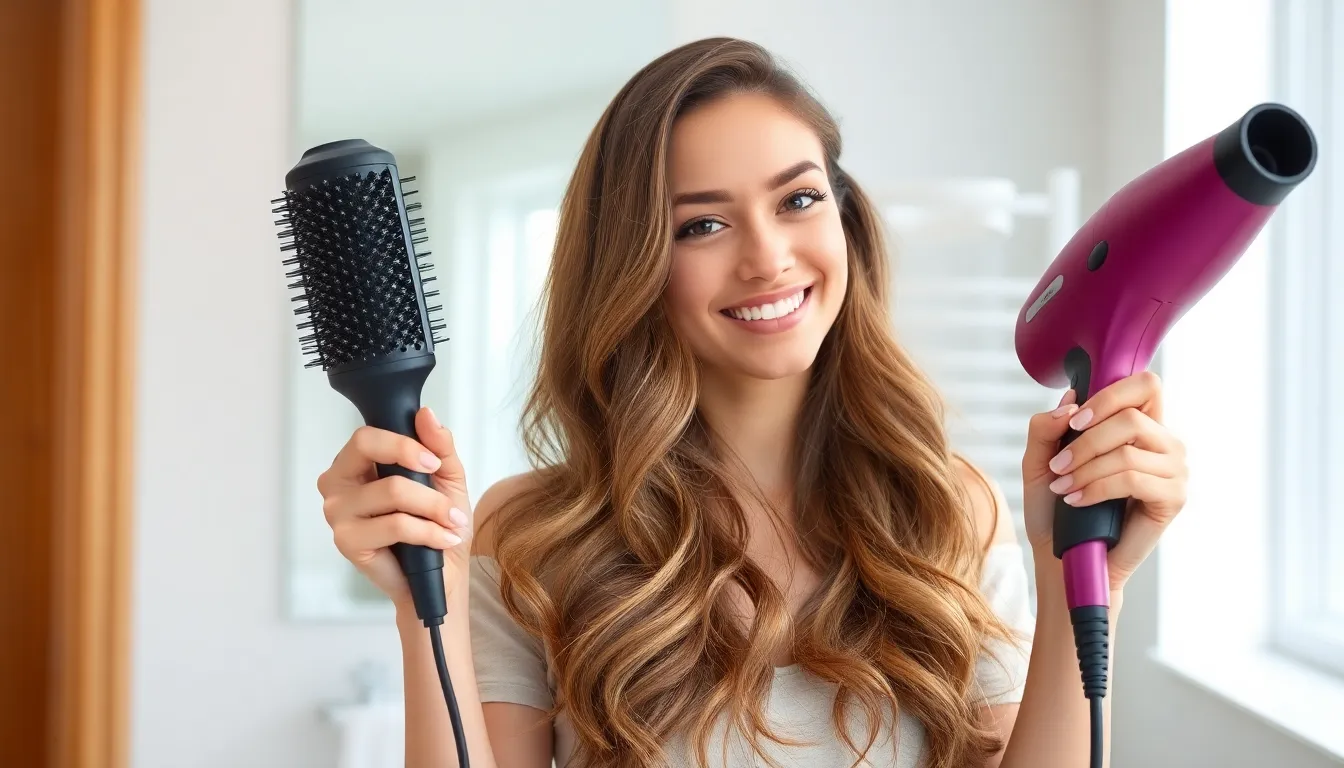
Strategic styling techniques can transform greasy hair into voluminous, manageable locks that look fresh throughout the day. These methods work alongside your product selection to create lasting results.
Blow-Drying Methods to Add Volume
Upside down drying creates maximum lift at the roots while reducing the appearance of oiliness. Flip your head forward and direct the airflow from roots to ends using a round brush to lift sections away from your scalp. This technique prevents hair from lying flat against your head where it can absorb more oils.
Root lifting with a blow dryer requires strategic sectioning and proper brush placement. Use a paddle brush to lift small sections straight up while applying heat from underneath. Focus the airflow on your roots for 10-15 seconds per section to create lasting volume that pushes hair away from oily areas.
Cool air finishing seals the hair cuticle and locks in volume while preventing excess oil production. Switch your blow dryer to the cool setting for the final 2-3 minutes of styling. Direct the cool air from roots to ends to set your style and reduce the likelihood of quick oil buildup.
Sectional drying ensures thorough moisture removal that could otherwise contribute to a greasy appearance. Divide your hair into 4-6 sections using clips and dry each section completely before moving to the next. Incomplete drying can create damp spots that appear oily and flat against your scalp.
Hairstyles That Hide Greasy Roots
Textured updos camouflage oily roots while creating sophisticated looks that last all day. Pull your hair into a messy bun or twisted chignon that keeps the greasiest parts hidden at the base of your neck. These styles work best with second or third day hair when natural oils provide grip for holding pins and accessories.
Braided styles redirect attention away from your roots while incorporating the natural texture that oily hair provides. French braids, dutch braids, and side braids all start close to your scalp where oils tend to concentrate. The braiding process distributes oils along the hair shaft while creating intricate patterns that draw focus away from any greasiness.
Side parts with volume shift the weight distribution of your hair to minimize the appearance of flat, oily roots. Create a deep side part and tease the hair on the heavier side for added lift. This asymmetrical styling technique breaks up the uniform flatness that often characterizes greasy hair.
Half up styles combine the benefits of updos with the coverage of down hair. Pull the top section of your hair into a high ponytail or topknot while leaving the bottom layers loose. This approach hides the oiliest crown area while maintaining length and movement in your overall style.
Heat Styling Tips for Greasy Hair
Lower temperature settings prevent overstimulation of your sebaceous glands while still achieving your desired style. Keep flat irons below 300°F and curling irons under 350°F to avoid triggering additional oil production. Higher temperatures can cause your scalp to compensate with increased sebum output within hours of styling.
Sectioning for efficiency reduces the total heat exposure time while ensuring even styling results. Work with 1-inch sections for flat ironing and 2-inch sections for curling to minimize passes over each strand. Multiple passes with high heat can stimulate oil glands and create a greasy appearance by midday.
Heat protectant application creates a barrier between your hair and styling tools while adding texture that combats flatness. Apply lightweight, alcohol based heat protectants to damp hair before blow drying. Avoid oil based protectants that can add to the greasy appearance you’re trying to minimize.
Root avoidance prevents direct heat application to the area where oils concentrate most heavily. Start your flat iron or curling iron at least 2 inches away from your scalp to avoid stimulating additional sebum production. Focus heat styling efforts on mid lengths and ends where natural oils provide beneficial protection and shine.
Exploring Natural Remedies for Greasy Hair

Natural ingredients offer powerful answers for managing oily hair without the harsh chemicals found in commercial products. Many of these remedies work by balancing scalp pH levels and gently removing excess sebum while nourishing hair follicles.
Apple Cider Vinegar Rinses
Apple cider vinegar creates an acidic environment that naturally dissolves oil buildup and restores scalp pH balance. The acetic acid in ACV helps remove product residue and excess sebum while smoothing hair cuticles for reduced frizz and enhanced shine.
Mix one part raw apple cider vinegar with three parts cool water in a spray bottle. Apply this solution to damp hair after shampooing, focusing on the scalp and roots where oil accumulates most. Allow the rinse to sit for 2-3 minutes before thoroughly rinsing with cool water.
Use ACV rinses once or twice weekly to avoid over-drying your scalp. Start with a more diluted ratio of 1:4 if you have sensitive skin, then gradually increase concentration as your scalp adjusts. The vinegar smell dissipates quickly once hair dries, leaving behind clean, manageable locks.
Clay Masks for Scalp Treatment
Bentonite and kaolin clays absorb excess oil while drawing impurities from hair follicles and scalp pores. These natural minerals create a deep-cleansing treatment that removes buildup without stripping essential moisture from your hair strands.
Create a paste using 2 tablespoons of clay powder mixed with enough water to form a spreadable consistency. Apply the mixture directly to your scalp and roots, avoiding the mid-lengths and ends of your hair. Leave the mask on for 10-15 minutes until it feels tight but not completely dry.
Rinse clay masks thoroughly with lukewarm water followed by your regular shampoo routine. Use clay treatments once weekly for oily scalps or bi-weekly for normal to combination hair types. Adding a few drops of tea tree oil to your clay mask enhances its oil-controlling properties while providing antimicrobial benefits.
Tea Tree Oil and Other Essential Oils
Tea tree oil possesses natural antiseptic properties that help control sebum production while preventing scalp irritation. This powerful essential oil penetrates hair follicles to reduce inflammation and balance oil levels without causing dryness or flaking.
Add 3-5 drops of tea tree oil to your regular shampoo or mix it with a carrier oil like jojoba for pre-wash treatments. Rosemary essential oil stimulates circulation and promotes healthy hair growth while regulating oil production. Peppermint oil provides a cooling sensation that soothes irritated scalps while controlling excess sebum.
Always dilute essential oils before applying them to your scalp to prevent irritation or allergic reactions. Lavender oil offers gentle oil control with calming aromatherapy benefits, making it ideal for stress-related hair oiliness. Lemon essential oil provides natural astringent properties that help remove buildup while adding shine to dull, greasy hair.
Avoiding Common Mistakes That Worsen Greasy Hair
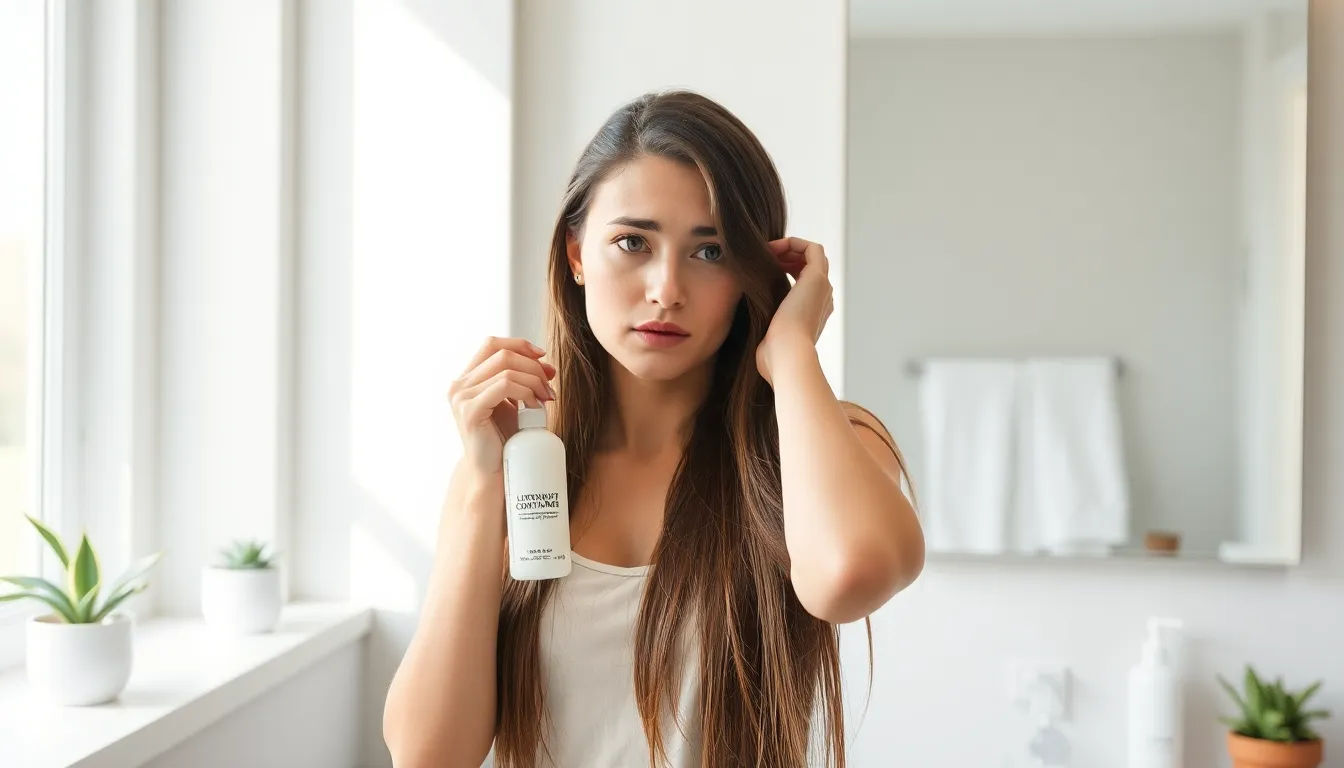
Making certain hair care errors can actually increase oil production and leave your hair looking greasier than before. We’ve identified the most common mistakes that sabotage your efforts to achieve fresh, clean hair.
Over-Conditioning Your Hair
Conditioning your hair too frequently creates a heavy buildup that weighs down strands and traps excess sebum. We see many people apply conditioner every day without realizing it’s making their greasy hair worse. Your scalp produces natural oils that fine and oily hair types don’t need supplemented with daily conditioning treatments.
Applying conditioner to your roots represents one of the biggest conditioning mistakes you can make. Focus conditioner application only on the mid-lengths and ends of your hair, where natural oils from your scalp don’t reach as easily. Skip conditioning altogether on days when your hair feels particularly oily or heavy.
Heavy, cream-based conditioners contain moisturizing agents like shea butter and coconut oil that create buildup on already oily hair. Switch to lightweight, water-based conditioners that hydrate without adding extra weight to your strands. Limit conditioning to every other wash or twice per week maximum if you have fine, oily hair.
Using Too Much Product
Overloading your hair with styling products creates layers of buildup that attract dirt and make your hair appear greasier faster. We recommend using no more than a dime-sized amount of any styling product, regardless of your hair length. Start with less product and gradually add more if needed rather than applying too much initially.
Layering multiple products compounds the greasy appearance by creating a heavy coating on your hair shaft. Choose one primary styling product per styling session instead of combining serums, creams, and gels together. Water-based formulas work better than oil-based products for managing greasy hair concerns.
Product application technique affects how quickly your hair becomes oily throughout the day. Apply styling products starting from the mid-lengths of your hair and working toward the ends, avoiding your scalp and root area entirely. This prevents product buildup from mixing with your natural sebum production.
Neglecting Scalp Care
Ignoring your scalp health allows dead skin cells, product residue, and excess oil to accumulate and create an environment for increased sebum production. We recommend incorporating gentle scalp exfoliation into your routine once or twice per week using a soft-bristled brush or scalp scrub. This removes buildup that can clog hair follicles and stimulate more oil production.
Failing to massage your scalp during shampooing prevents thorough cleansing and allows oil to remain trapped near your roots. Spend at least 60 seconds gently massaging shampoo into your scalp using your fingertips, not your nails, to lift away oil and debris effectively. Proper scalp massage also improves blood circulation, which can help regulate sebum production over time.
Skipping regular scalp treatments leaves your hair vulnerable to imbalanced pH levels and bacterial growth that can worsen greasy hair conditions. Use clarifying treatments or apple cider vinegar rinses weekly to maintain proper scalp pH and remove stubborn buildup that regular shampooing can’t eliminate. A healthy scalp environment produces less excess oil and maintains cleaner-looking hair for longer periods.
Knowing When to Seek Professional Help

Sometimes greasy hair persists even though our best efforts to manage it naturally. Recognizing when it’s time to consult a professional can save months of frustration and help address underlying issues.
Persistent Oily Hair Even though Changes
Consistent greasy hair after 6-8 weeks of proper washing routines signals potential deeper issues. We recommend tracking your hair’s oil production patterns to identify whether changes in frequency or products make any difference. Scalps that produce excessive oil within hours of washing may indicate hormonal imbalances or genetic predispositions requiring medical attention.
Daily greasiness that doesn’t respond to clarifying shampoos or sulfate-free formulas suggests your sebaceous glands might be overproducing sebum due to medical conditions. Thyroid disorders and insulin resistance frequently manifest through persistently oily hair that remains unmanageable regardless of product choices. Professional evaluation becomes essential when dietary changes and proper hydration fail to reduce oil production over several months.
Signs of Underlying Scalp Conditions
Scalp inflammation accompanied by excess oil production often indicates seborrheic dermatitis or other medical conditions requiring professional diagnosis. We notice that yellow or white flakes combined with greasy hair frequently signal scalp conditions beyond typical dandruff. Itching, burning sensations, or unusual odors from your scalp warrant immediate medical attention.
Red patches on your scalp alongside persistent greasiness may indicate psoriasis or allergic reactions to hair products. Sudden changes in oil production patterns without lifestyle modifications can suggest hormonal fluctuations or medication side effects. Hair thinning combined with excessive oiliness requires professional assessment to rule out conditions like androgenetic alopecia or polycystic ovary syndrome.
Benefits of Professional Hair Treatments
Professional scalp treatments offer deep cleansing techniques that remove stubborn oil buildup beyond what home remedies achieve. Dermatologists can prescribe medicated shampoos containing ketoconazole or selenium sulfide to address underlying scalp conditions causing excess oil. Salon treatments like scalp facials and oxygen therapy help regulate sebum production while improving circulation.
Trichologists provide specialized scalp analysis to identify exact causes of your greasy hair and create personalized treatment plans. Professional chemical peels for the scalp can reset oil production cycles and remove years of product buildup. Prescription treatments for hormonal imbalances often prove more effective than over-the-counter answers when addressing persistent greasy hair issues.
Conclusion
We’ve covered comprehensive strategies to help you win the battle against greasy hair. From understanding your scalp’s unique needs to implementing proper washing techniques and choosing the right products you can transform your hair care routine and achieve the fresh clean look you’re after.
Remember that managing oily hair isn’t about harsh treatments or expensive products. It’s about finding the right balance for your exact hair type and sticking to consistent healthy habits. Whether you’re adjusting your diet incorporating natural remedies or perfecting your styling technique every small change contributes to better hair health.
The journey to healthier hair takes patience but with these proven strategies you’re well-equipped to tackle excess oil and boost your confidence. Start with one or two changes and gradually build your routine until you find what works best for your unique needs.
Frequently Asked Questions
What causes greasy hair?
Greasy hair is primarily caused by overactive sebaceous glands that produce excess sebum (natural oil). Contributing factors include genetics, hormonal imbalances (especially androgens), stress, environmental irritants, and paradoxically, overwashing your hair. Your family history, age, and ethnic background also play significant roles in determining your hair’s oil production levels.
How often should I wash greasy hair?
Start by washing every other day and adjust based on your scalp’s response. Fine hair typically needs more frequent washing than coarser textures. Avoid daily washing as it can strip natural oils and trigger your scalp to produce even more sebum, creating a frustrating cycle of increased greasiness.
What type of shampoo is best for oily hair?
Use clarifying shampoos 1-2 times weekly for deep cleansing and oil removal. For sensitive scalps, choose sulfate-free options with natural ingredients that regulate sebum without irritation. Dry shampoos work great for quick fixes between washes but shouldn’t replace regular cleansing. Avoid daily use of harsh clarifying shampoos.
Can diet affect how greasy my hair gets?
Yes, diet significantly impacts sebum production. Avoid refined sugars, processed foods, dairy, fried foods, and high glycemic index items that can increase oil production. Instead, consume omega-3 fatty acids, zinc, vitamin A, B vitamins, and antioxidant-rich foods. Stay well-hydrated as proper water intake helps regulate sebum levels.
What styling products won’t make my hair greasier?
Choose lightweight, water-based conditioners and apply only to mid-lengths and ends. Use oil-free styling products like water-based gels and alcohol-based sprays that provide hold without residue. Volumizing products such as root-lifting sprays and dry texturizing sprays add body while managing oiliness without weighing hair down.
Are there natural remedies for greasy hair?
Apple cider vinegar rinses help dissolve oil buildup and restore scalp pH balance. Clay masks absorb excess oil and draw out impurities without stripping moisture. Tea tree oil and other essential oils can control sebum production and soothe the scalp when properly diluted and used in moderation.
What common mistakes make greasy hair worse?
Over-conditioning creates buildup and weighs hair down. Using too much styling product (use only dime-sized amounts) and applying products too close to the scalp worsens greasiness. Excessive touching, brushing, and using dirty brushes redistribute oils. Hot water and aggressive scrubbing stimulate more oil production, so use lukewarm water instead.
When should I see a professional about greasy hair?
Seek professional help if your hair remains consistently greasy after 6-8 weeks of proper care, as this may indicate hormonal imbalances or genetic factors. Signs of scalp conditions like inflammation, unusual odors, or persistent irritation warrant immediate medical attention. Professionals can provide specialized treatments and personalized solutions.







